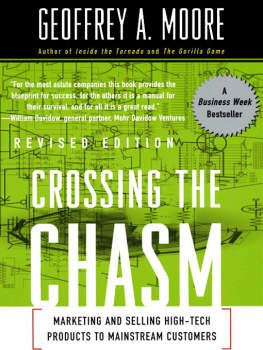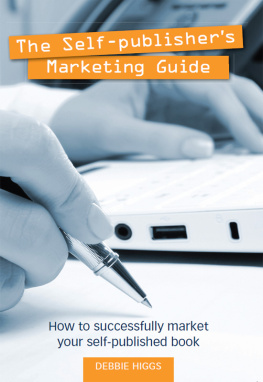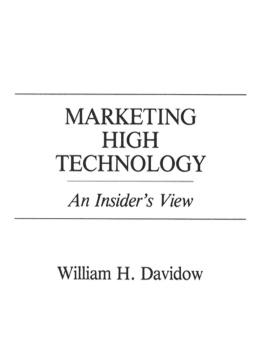Moore - Crossing the chasm: marketing and selling technology project
Here you can read online Moore - Crossing the chasm: marketing and selling technology project full text of the book (entire story) in english for free. Download pdf and epub, get meaning, cover and reviews about this ebook. year: 2012;2014, publisher: HarperCollins e-Books, genre: Business. Description of the work, (preface) as well as reviews are available. Best literature library LitArk.com created for fans of good reading and offers a wide selection of genres:
Romance novel
Science fiction
Adventure
Detective
Science
History
Home and family
Prose
Art
Politics
Computer
Non-fiction
Religion
Business
Children
Humor
Choose a favorite category and find really read worthwhile books. Enjoy immersion in the world of imagination, feel the emotions of the characters or learn something new for yourself, make an fascinating discovery.
- Book:Crossing the chasm: marketing and selling technology project
- Author:
- Publisher:HarperCollins e-Books
- Genre:
- Year:2012;2014
- Rating:5 / 5
- Favourites:Add to favourites
- Your mark:
- 100
- 1
- 2
- 3
- 4
- 5
Crossing the chasm: marketing and selling technology project: summary, description and annotation
We offer to read an annotation, description, summary or preface (depends on what the author of the book "Crossing the chasm: marketing and selling technology project" wrote himself). If you haven't found the necessary information about the book — write in the comments, we will try to find it.
Crossing the chasm: marketing and selling technology project — read online for free the complete book (whole text) full work
Below is the text of the book, divided by pages. System saving the place of the last page read, allows you to conveniently read the book "Crossing the chasm: marketing and selling technology project" online for free, without having to search again every time where you left off. Put a bookmark, and you can go to the page where you finished reading at any time.
Font size:
Interval:
Bookmark:
To Marie
PART I
Discovering the Chasm
Introduction
If Bill Gates Can Be a Billionaire
PART II
Crossing the Chasm
Obiwan Kenobi, says Sir Alec Guinness in the original Star Wars movieNow theres a name I havent heard for a long, long time.
The same might well be said of a number of the companies that served as examples in the original edition of Crossing the Chasm. Reading through its index brings to mind the medieval lament, Where are the snows of yesteryear? Where indeed are Aldus, Apollo, Ashton-Tate, Ask, Burroughs, Businessland, and the Byte Shop? Where are Wang, Weitek, and Zilog? Oh lost and by the wind-grieved ghosts, come back again!
But we should not despair. In high tech, the good news is that, although we lose our companies with alarming frequency, we keep the people along with the ideas, and so the industry as a whole goes forward vibrantly, even as the names on our paychecks slide into another seamlessly (OK, as seamlessly as our systems interoperate, which as marketing claims is... well thats another matter).
Crossing the Chasm was written in 1990 and published in 1991. Originally forecast to sell 5,000 copies, it has over a seven year period in the market sold more than 175,000. In high-tech marketing, we call this an upside miss. The appeal of the book, I believe, is that it puts a vocabulary to a market development problem that has given untold grief to any number of high-tech enterprises. Seeing the problem externalized in print has a sort of redemptive effect on people who have fallen prey to it in the pastit wasnt all my fault! Moreover, like a good book on golf, its prescriptions give great hope that just by making this or that minor adjustment perfect results are bound to followthis time well make it work! And so any number of people cheerfully have told me that the book has become the Bible in their company. So much for the spiritual health of our generation.
In editing this revised edition, I have tried to touch as little as possible the logic of the original. This is harder than you might think because over the past decade my views have changed (all right, Ive become older), and I have an inveterate tendency to meddle, as any number of my clients and colleagues will testify. The problem is, when you meddle, you get in deeper and deeper until God knows what you have, but it wasnt what you started with. I have plenty enough opportunity to do that with future books, and I have enough respect for this one to try to stand off a bit.
That being said, I did make a few significant exceptions. I eliminated the section on using thematic niches as a legitimate tactic for crossing the chasm. It turns out instead they were a placeholder for the market tactics used during a merging hypergrowth market, a challenge covered in a subsequent book, Inside the Tornado. Also I have substituted a revised scenario process for the original to incorporate improvements that have evolved over the past several years of consulting at The Chasm Group. Elsewhere, I took a slightly new angle on creating the competition and, when it came to the section on distribution, I have done my best to incorporate the emerging influence of the Internet.
But the overwhelming bulk of the changes in this new editionrepresenting about a third of total textsimply swap out the original examples from the 1980s with new ones from the 1990s. Surprisingly, in the majority of cases this swap works very well. But in other cases, theres been a little force-fitting, and I want to beg your indulgence up front. The world has changed. The high-tech community is now crossing the chasm intentionally rather than unintentionally, and there are now competitors who have read the same book and create plans to block chasm-crossing. The basic forces dont change, but the tactics have become more complicated.
Moreover, we are seeing a new effect which was just barely visible in the prior decade, the piggybacking of one companys offer on another to skip the chasm entirely and jump straight into hypergrowth. In the 1980s Lotus piggybacked on VisiCalc to accomplish this feat in the spreadsheet category. In the 1990s Microsoft has done the same thing to Netscape in browsers. The key insight here is that we should always be tracking the evolution of a technology rather than a given companys product lineits the Technology Adoption Life Cycle, after all. Thus it is spreadsheets, not VisiCalc, Lotus, or Excel, that is the adoption category, just as it is browsers, not Navigator or Explorer. In the early days products and categories were synonymous because technologies were on their first cycles. But today we have multiple decades of invention to build on, and a new offer is no longer quite as new or unprecedented as it used to be. The marketplace is therefore able to absorb this not-quite-so-newtechnology in gulps, for a while letting one company come to the fore, but substituting another should the first company stumble.
Finally, let me close by noting technological changes do not live in isolation but rather come under the influence of changes in surrounding technologies as well. In the early 90s it was the sea change to graphical user interfaces and client-server topologies that created the primary context. As we come to the close of the century it is the complete shift of communications infrastructure to the Internet. These major technology shifts create huge sine waves of change that interact with the smaller sine waves of more local technology shifts, occasionally synthesizing harmonically, more frequently playing out some discordant mix that has customers growling and investors howling.
Navigating in such uncharted waters requires beacons that can be seen above the waves, and that is what models in general, and the chasm models in particular, are for. Models are like constellationsthey are not intended to change in themselves, but their value is in giving perspective on a highly changing world. The chasm model represents a pattern in market development that is based on the tendency of pragmatic people to adopt new technology when they see other people like them doing the same. This causes them to hang together as a group, and the groups initial reaction, like teenagers at a junior high dance, is to hesitate and watch. This is the chasm effect. The tendency is very deep-rooted, and so the pattern is very persistent. As a result, marketers can predict its appearance and build strategies to cope with it, and it is the purpose of this book to help in that process.
But fixing your position relative to the North Star does not keep water out of the boat. As the French proverb says, God loves a sailor, but he has to row for himself. And in that act of rowing the work is huge and the risks high, and every reader of this book who is also a practitioner of high-tech market development has my deepest respect.
With that thought in mind, let me turn you over now to Regis McKenna, author of the original Foreword back in 1991, and then to a fledgling author writing his first acknowledgments.
Within an ever-changing society, marketing represents the ongoing effort to keep the means of productionour products and servicesin touch with evolving social and personal conditions. That keeping in touch has become our greatest challenge.
In an era when the pace of change was slower, the variety of products and services fewer, the channels of communication and distribution less pervasive, and the consumer less sophisticated, marketing could enjoy prolonged periods of relative stability, reaping profits from holding the customer constant and optimizing the other variables. That is no longer the case.
We live in an age of choice. We are continually bombarded with purchasing alternatives in every aspect of our lives. This in turn has led us to develop an increasingly sophisticated set of defenses, so that any company seeking to establish a brand loyalty in us is going to be hard-pressed to succeed. We demand more and more from our purchases and our suppliers, leading to increasingly fragmented markets served by products that can be customized by design, programmability, service, or variety.
Font size:
Interval:
Bookmark:
Similar books «Crossing the chasm: marketing and selling technology project»
Look at similar books to Crossing the chasm: marketing and selling technology project. We have selected literature similar in name and meaning in the hope of providing readers with more options to find new, interesting, not yet read works.
Discussion, reviews of the book Crossing the chasm: marketing and selling technology project and just readers' own opinions. Leave your comments, write what you think about the work, its meaning or the main characters. Specify what exactly you liked and what you didn't like, and why you think so.












